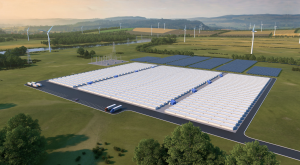Climate Change Resists Narrative, Yet the Alphabet Prevails (A to Z): Now H!

Cambridge Energy Storage Project, a demonstration plant in Minnesota operated by Great River Energy that will use Form Energy’s “iron-air” battery technology.
From an Article by Elizabeth Kolbert, New Yorker Magazine, 11/28/22
“Hope is the pillar that holds up the world,” Pliny the Elder is supposed to have observed. “Hope is the dream of a waking man.” Go looking for hopeful climate stories and they turn up everywhere.
Not long ago, I came across one in a defunct wine distributorship, in Somerville, Massachusetts. The cavernous warehouse had been taken over by a company called Form Energy, whose waking dream concerns rust. Rusting usually proceeds in one direction, and the end result is a corroded nail or screw that winds up in the trash. But, as iron oxidizes, it gives up electrons.
Therefore, if a current is applied to rust in solution, the process will run in reverse. At Form, the goal is to use this reverse-rusting trick to make a new kind of battery, one so cheap and durable it could power an entire city.
Billy Woodford, Form’s chief technology officer, studied material science at M.I.T. “Batteries have cool technical problems,” he told me as we descended into the warehouse turned research lab. The huge room was lined with experimental chambers that resembled glass-fronted refrigerators. Each was labelled, according to an inside joke that I never quite got, with the name of a different Oreo variety, like lemon or s’mores or gluten free.
Inside the chambers were collections of some kind of high-tech Tupperware, with wires poking through the lids. The containers, in turn, held plates of iron bathing in liquid. Woodford explained that these were test batteries: “We’ll put in different iron — there’s different versions, depending on whether it’s produced, say, in Texas or Germany — and then different electrolytes.”
Iron-air batteries’ active components are iron, salt water, and air. They can soak up energy from wind farms, feeding it into the grid when needed. Form Energy’s full-scale batteries will be packaged into modules of fifty, each about the size of a washer and dryer placed side by side. Ten of the modules will be big enough to fill a shipping container. On blustery days, they charge, using an electric current to convert rust into iron. On calm days, the iron rusts and releases electricity into the grid.
The first thirty shipping containers’ worth have been promised to Great River Energy, a Minnesota-based utility that buys a lot of wind power. (See the conceptual plant layout photo above.)
Form’s C.E.O., Mateo Jaramillo, studied theology and later became a Tesla executive. While at Tesla, he worked on lithium-ion batteries, which are the sort used in most electric vehicles (and in the Alia), and also, in a slightly different form, in laptops and cell phones.
“Lithium-ion is fantastic,” Jaramillo told me. “And yet, if that’s the only tool you have, you still have a really hard time replacing high- capacity coal and natural-gas plants. To replace those, you need something that’s at least an order of magnitude cheaper than lithium-ion.” The materials needed for reversible rusting — air, salt water, and iron — are available in practically limitless quantities. “Besides coal, iron is the most-mined mineral on earth,” Jaramillo said. “So it scales.”
#######+++++++#######+++++++#######
Billionaire-backed ‘Iron-Air’ Battery Maker Picks WV Site for First Factory, Darrell Proctor, POWER Magazine, December 23, 2022
A battery manufacturing company with plenty of high-profile financial backing said it has picked a site for its first factory that will build “iron-air” batteries. Form Energy touts its technology as a breakthrough for long-duration storage of solar and wind power.
Form, which counts Microsoft founder Bill Gates, Amazon’s Jeff Bezos, and British tycoon Richard Branson among its supporters, was founded in 2017 by veterans of the energy storage sector. The group said its mission was to create low-cost, multi-day energy storage systems. Company officials have said their iron-air battery can store electricity for as much as 100 hours. They’ve also said the technology will be competitive with electricity produced by traditional power plants.
Form, which is headquartered in Somerville, Massachusetts, on Dec. 22 said it will begin construction of its first factory in Weirton, West Virginia, in 2023. The company expects to begin manufacturing commercial iron-air battery systems the following year. The plant’s cost is estimated at about $760 million, and officials said the project would create 750 jobs. Form completed a $450 million Series E funding round in October.
Incentive Package ~ West Virginia Gov. Jim Justice said his state is providing Form with an incentive package worth as much as $290 million in what he called asset-based, performance financing for the factory’s construction. The package includes $75 million for land purchase and building construction in Weirton. Justice said he will work with state lawmakers and the federal government to obtain an additional $215 million.
Mateo Jaramillo, Form’s CEO and co-founder, said Weirton was chosen from among more than 500 possible locations for the company’s manufacturing plant. He called Weirton “a historic steel community that sits on a river and has the rich heritage and know-how to make great things out of iron.” Jaramillo, who headed Tesla’s energy-storage business before leaving in 2016, said his company expects “to be generating meaningful revenue in 2025.”